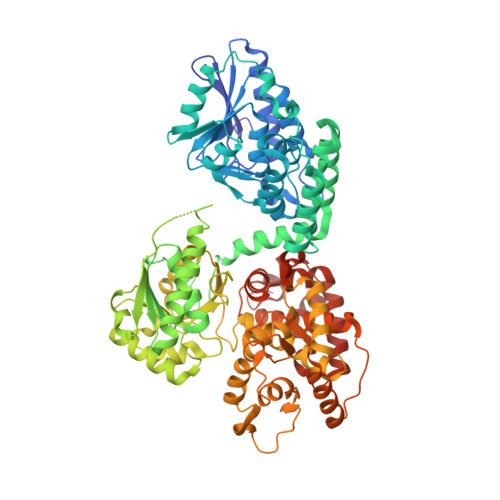Crystallographic binding studies of rat peroxisomal multifunctional enzyme type 1 with 3-ketodecanoyl-CoA: capturing active and inactive states of its hydratase and dehydrogenase catalytic sites.
Sridhar, S., Schmitz, W., Hiltunen, J.K., Venkatesan, R., Bergmann, U., Kiema, T.R., Wierenga, R.K.(2020) Acta Crystallogr D Struct Biol 76: 1256-1269
- PubMed: 33263331
- DOI: https://doi.org/10.1107/S2059798320013819
- Primary Citation of Related Structures:
6Z5F, 6Z5O, 6Z5V - PubMed Abstract:
The peroxisomal multifunctional enzyme type 1 (MFE1) catalyzes two successive reactions in the β-oxidation cycle: the 2E-enoyl-CoA hydratase (ECH) and NAD + -dependent 3S-hydroxyacyl-CoA dehydrogenase (HAD) reactions. MFE1 is a monomeric enzyme that has five domains. The N-terminal part (domains A and B) adopts the crotonase fold and the C-terminal part (domains C, D and E) adopts the HAD fold. A new crystal form of MFE1 has captured a conformation in which both active sites are noncompetent. This structure, at 1.7 Å resolution, shows the importance of the interactions between Phe272 in domain B (the linker helix; helix H10 of the crotonase fold) and the beginning of loop 2 (of the crotonase fold) in stabilizing the competent ECH active-site geometry. In addition, protein crystallographic binding studies using optimized crystal-treatment protocols have captured a structure with both the 3-ketodecanoyl-CoA product and NAD + bound in the HAD active site, showing the interactions between 3-ketodecanoyl-CoA and residues of the C, D and E domains. Structural comparisons show the importance of domain movements, in particular of the C domain with respect to the D/E domains and of the A domain with respect to the HAD part. These comparisons suggest that the N-terminal part of the linker helix, which interacts tightly with domains A and E, functions as a hinge region for movement of the A domain with respect to the HAD part.
Organizational Affiliation:
Faculty of Biochemistry and Molecular Medicine, University of Oulu, Oulu, Finland.


















